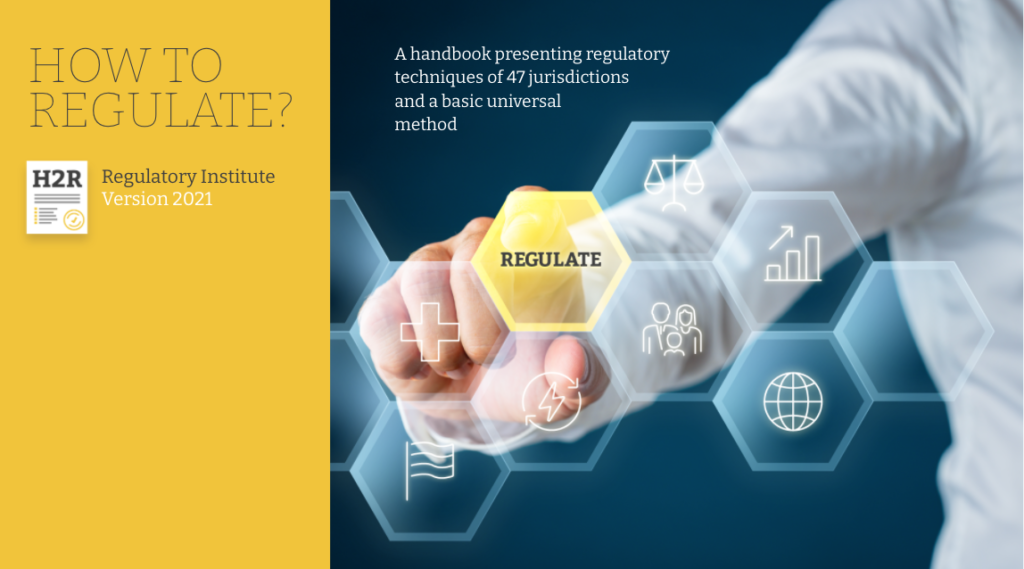The Handbook: How to regulate? presents an inventory of regulatory techniques from over 40 jurisdictions and a basic universal method. The Handbook is based on the idea that officials with an inventory of regulatory techniques have more choices and can develop better regulations. The same goes for officials using methodological knowledge. The Handbook is made available free of charge because better regulations benefit us all.
Access to the Handbook 2nd ed. 2021 (English).

Please contact us if interested in other translations.
From the 1st to the 2nd edition: What is new?
The first edition of the Handbook was released in 2014 by the author and Founder of the Regulatory Institute, Mr Manfred Kohler, an official of the European Union with more than 20 years of experience in law-making in various national and international contexts. Whilst it has been successfully used by government officials and parliamentarians in the Americas, Europe, Africa, and Asia, it was still based on regulatory techniques identified from a smaller base of jurisdictions (9).
The second edition of the Handbook has a much broader empirical basis. It cites regulatory techniques from 47 jurisdictions and 82 different regulatory sectors (domains). On the methodological side, it goes beyond the first edition by presenting two additional perspectives on regulation:
-
a macro-view: an introduction into the topic of regulatory architecture (Chapter 2) that can help in the harmonious configuration of different pieces of regulation, and
-
a micro-view: a typology of requirements and other provisions (Chapter 3) that helps to complement or otherwise improve individual provisions.
These two new chapters and about 70 new sections or sub-sections complement the inventory of regulatory techniques and methodology of the first edition.
The Handbook 2nd ed. is edited by the Regulatory Institute. It integrates the knowledge and good examples of regulation identified by the Regulatory Institute since the first edition’s release.
The identification of generally interesting and useful regulatory techniques in so many different and diverse jurisdictions and 82 different regulatory sectors (domains) confirmed a basic assumption of this Handbook: the topic “regulatory techniques” is universal, not limited to specific jurisdictions or sectors. Regulators can all learn from each other, across jurisdictions and sectors, by profiting from the remarkable intelligence laid down in existing legislation, just made easily accessible via the Handbook.
Access to Handbook 1st ed. 2014 (English original, French translation).
How to use the Handbook
The purpose of the Handbook is to assist officials involved in regulatory activities. Readers can draw inspiration from it, can learn how colleagues have tackled a certain regulatory challenge and can even develop a tailor-made systematic approach to improve their regulation. The Handbook can also be used as a basis for training courses or for self-training.
The Handbook is not intended to be read from A to Z. Instead, readers are invited to pick and choose the sections that are relevant to them. The Handbook was not developed to be the authoritative source of how to regulate, but to offer in the most neutral and objective way possibilities for improving regulation.
More on the content of the Handbook
The Handbook explores the empty space between:
- the constitution or similar documents setting the legal frame,
- the sector-specific policies followed by the government, administration, or institution,
- the impact assessment, better regulation, simplification, and other regulatory policies,
- applicable drafting instructions or recommendations, and
- the procedural settings of the respective jurisdiction.
The chapters of the Handbook 2nd ed. cover the following:
- Introduction.
- The architecture of regulations.
- The small scale building blocks of regulation: the requirements and other provisions.
- Typology of incentives and regulatory measures.
- The method of regulating.
- The scope.
- Other basic questions of regulation.
- Understanding risks, quantified requirements and multi-dimensional impacts.
- References.
- Verifying conformity in advance (ex ante).
- Ex post verification / enforcement.
- Other implementation questions.
- Miscellaneous: transitional provisions, validity of decisions, applicability of other regulations etc.
- Working methods and ethics.
- Integral quality verification.